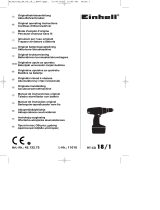GB
9
Screwing without hammer action
Vibration emission value a
h
≤ 2,5 m/s
2
K uncertainty = 1.5 m/s
2
Additional information for electric power tools
Warning!
The specified vibration value was established in
accordance with a standardized testing method. It
may change according to how the electric equipment
is used and may exceed the specified value in
exceptional circumstances.
The specified vibration value can be used to compare
the equipment with other electric power tools.
The specified vibration value can be used for initial
assessment of a harmful effect.
Keep the noise emissions and vibrations to a
minimum.
n Only use appliances which are in perfect working
order.
n Service and clean the appliance regularly.
n Adapt your working style to suit the appliance.
n Do not overload the appliance.
n Have the appliance serviced whenever
necessary.
n Switch the appliance off when it is not in use.
n Wear protective gloves.
Residual risks
Even if you use this electric power tool in
accordance with instructions, certain residual
risks cannot be rules out. The following hazards
may arise in connection with the equipment’s
construction and layout:
1. Lung damage if no suitable protective dust mask
is used.
2. Damage to hearing if no suitable ear protection is
used.
3. Health damage caused by hand-arm vibrations if
the equipment is used over a prolonged period or
is not properly guided and maintained.
5. Before starting the equipment
n Before you connect the equipment to the mains
supply make sure that the data on the rating
plate are identical to the mains data.
n Always pull the power plug before making
adjustments to the equipment.
n Only ever use screw gun bits which are suitable
for the purpose and in faultless condition.
n Before you begin to screw in walls and masonry,
check for concealed electric wiring, gas pipes
and water pipes.
n The screw gun is equipped with a claw coupling.
The spindle does not start to rotate until the
screw is pushed into the workpiece.
5.1 Setting the screwing depth (Figure 2)
Using the depth setting ring (2) with latching settings
you can pre-select the depth to which the screw is
screwed into the workpiece.
PLUS direction: larger screwing depth
MINUS direction: smaller screwing depth
The best way to determine the re-quired setting is
with a test screw.
Press the tip of the screw firmly against the material
in question until the screwing depth stop (1) comes
up against the workpiece and the coupling
disengages.
The scale (a) can serve as a rough guide if the depth
setting ring (2) should move or if several screwing
depths are needed in alternation.
5.2 Changing the tool insert
To change the tool insert, rotate the screwing depth
stop (1) with the depth setting ring (2) as far as the
maximum screwing depth and pull off the tool insert
to the front (use pincers if necessary).
5.3 Screwdriving work
It is advisable to use self-centering screws (e.g. Torx,
cross recessed head) as these will enable you to
work safely and reliably. Always make sure that the
tool insert used is of the same size and shape as the
screw.
6. Operation
6.1 ON/OFF switch (4)
To switch on:
Press the switch (4)
Continuous operation:
Secure the switch (4) with the locking button (5)
To switch off:
Press in the switch (4) briefly










